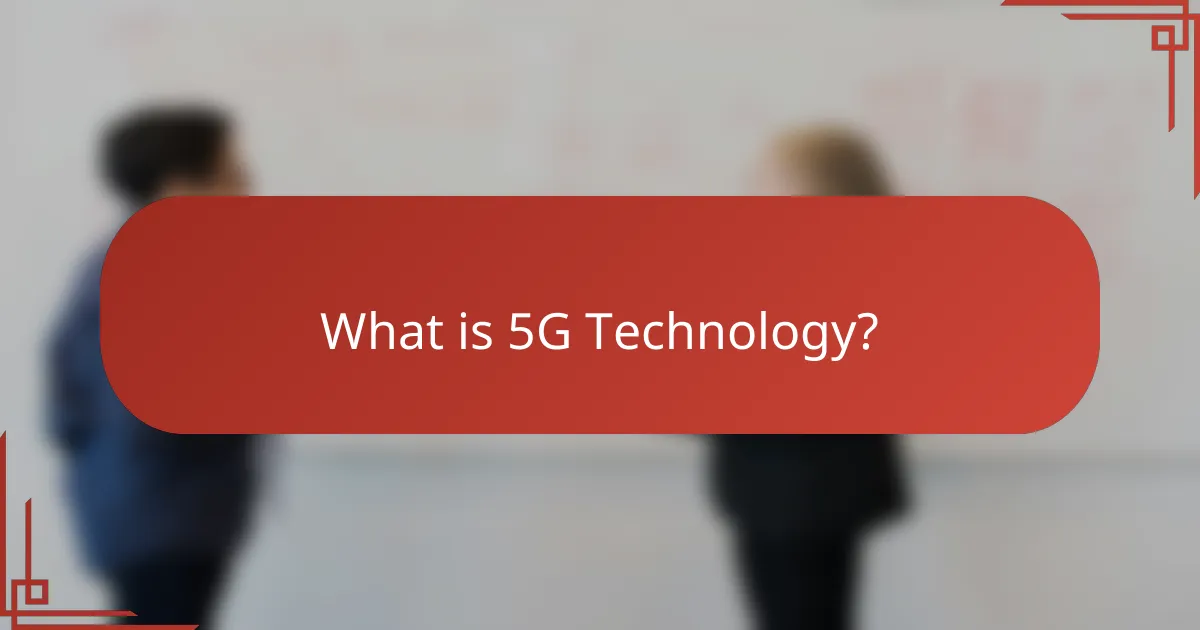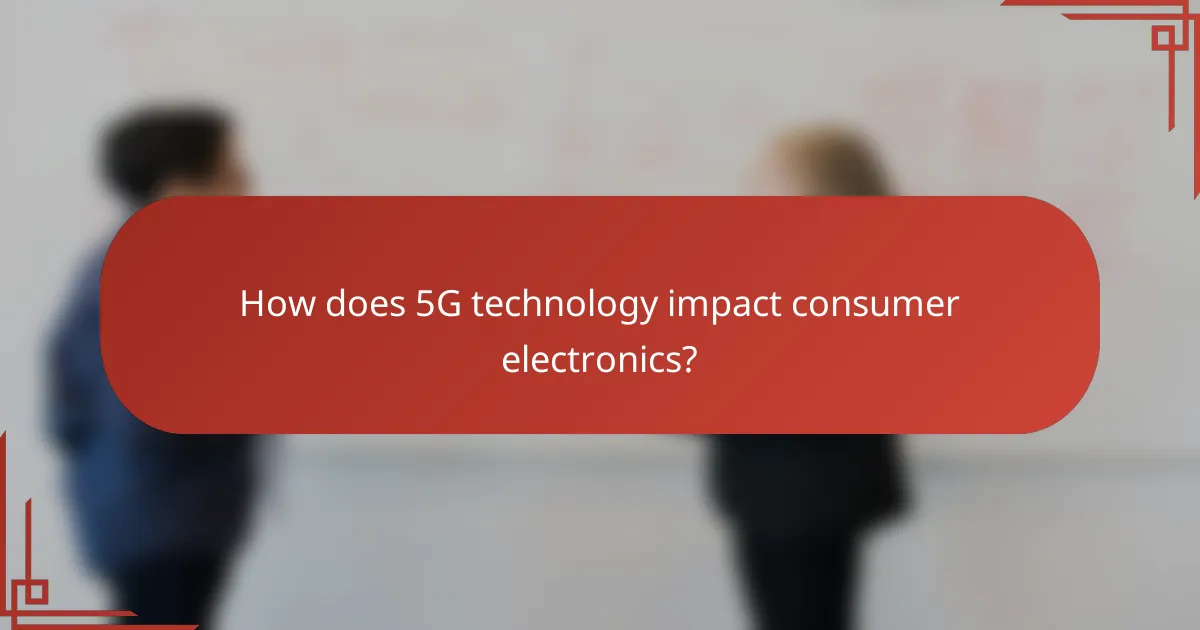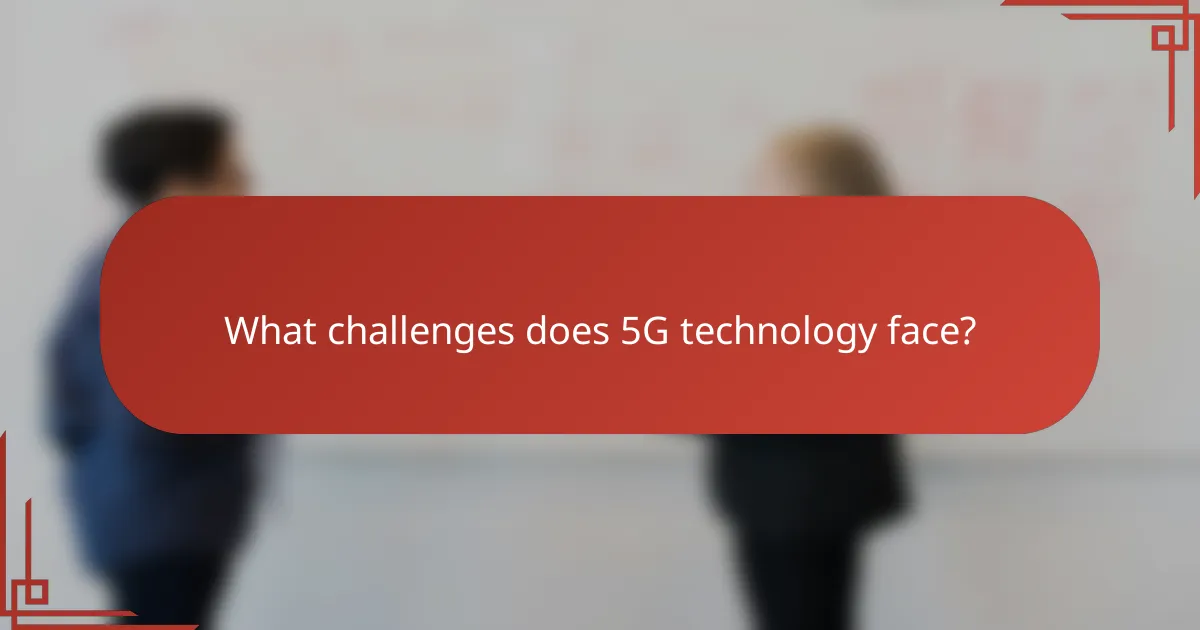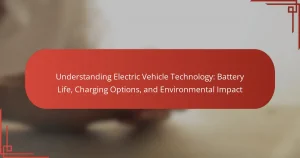5G technology represents the fifth generation of mobile network systems, delivering data speeds up to 10 Gbps and significantly reduced latency of just 1 millisecond. This advancement enables a higher density of connected devices, enhancing connectivity in urban areas and supporting the growing Internet of Things (IoT) ecosystem. The article examines the transformative impact of 5G on consumer electronics, including improvements in streaming, gaming, and smart home automation, while also addressing challenges such as infrastructure requirements, spectrum allocation, security vulnerabilities, and consumer adoption. Overall, the discussion highlights the critical role of 5G in advancing technologies like autonomous vehicles and smart cities.

What is 5G Technology?
5G technology is the fifth generation of mobile network technology. It offers significantly faster data speeds compared to its predecessor, 4G. 5G can achieve download speeds of up to 10 Gbps. This technology also features lower latency, with response times as low as 1 millisecond. 5G enables a greater number of connected devices per square kilometer, enhancing connectivity in crowded areas. It operates on a wider range of frequencies, including millimeter waves. This allows for higher capacity and better performance in urban environments. 5G technology is crucial for advancements in areas like autonomous vehicles and smart cities.
How does 5G technology differ from previous generations?
5G technology differs from previous generations primarily in speed, latency, and connectivity. It offers peak speeds of up to 10 Gbps, significantly faster than 4G’s maximum of 1 Gbps. The latency in 5G networks can be as low as 1 millisecond, compared to 30-50 milliseconds in 4G. This reduction enables real-time applications such as autonomous driving and remote surgery.
Additionally, 5G supports up to 1 million devices per square kilometer, greatly enhancing connectivity in crowded areas. It utilizes higher frequency bands, which allows for greater bandwidth but may require more infrastructure. Overall, these advancements position 5G as a transformative technology for various industries and consumer electronics.
What are the key features of 5G technology?
5G technology features ultra-fast data speeds, significantly lower latency, and enhanced capacity. It enables peak download speeds of up to 10 Gbps. This is 100 times faster than 4G technology. 5G reduces latency to as low as 1 millisecond. This allows real-time communication for applications like autonomous vehicles. The technology supports a higher density of devices, accommodating up to 1 million devices per square kilometer. 5G also offers improved energy efficiency, extending battery life for connected devices. Additionally, it provides enhanced network reliability, crucial for critical applications. These features collectively enhance user experiences across various consumer electronics.
Why is 5G considered a significant advancement in telecommunications?
5G is considered a significant advancement in telecommunications due to its enhanced speed, lower latency, and increased capacity. It offers download speeds up to 10 Gbps, which is up to 100 times faster than 4G. This speed allows for seamless streaming of high-definition content and rapid data transfer. Additionally, 5G reduces latency to as low as 1 millisecond. This improvement enables real-time communication for applications like remote surgery and autonomous vehicles. Furthermore, 5G can support up to 1 million devices per square kilometer. This capacity is crucial for the growing Internet of Things (IoT) ecosystem. Overall, these advancements position 5G as a transformative technology in the telecommunications landscape.
What are the main components of 5G technology?
The main components of 5G technology include the core network, radio access network, and user equipment. The core network manages data traffic and connectivity. It uses cloud-native architecture to enhance flexibility and scalability. The radio access network connects devices to the core network via various frequencies. It employs advanced technologies like Massive MIMO and beamforming. User equipment refers to devices that access the 5G network, such as smartphones and IoT devices. These components work together to deliver higher speeds, lower latency, and improved capacity compared to previous generations. 5G technology is designed to support a wide range of applications, from enhanced mobile broadband to critical communications.
How do small cells enhance 5G coverage?
Small cells enhance 5G coverage by providing localized network support. They are low-power base stations that improve signal strength in densely populated areas. This technology allows for more efficient use of the spectrum. Small cells can be deployed quickly and cost-effectively. They fill coverage gaps that macro cells cannot reach. According to a report by the Global Mobile Suppliers Association, small cells can increase capacity by up to 100 times in urban environments. Their ability to operate in various frequency bands further boosts network performance. Overall, small cells play a crucial role in delivering reliable 5G service.
What role do millimeter waves play in 5G performance?
Millimeter waves are crucial for enhancing 5G performance. They enable high data transmission speeds and increased bandwidth. Millimeter waves operate in the frequency range of 24 GHz to 100 GHz. This frequency range allows for faster data rates compared to lower frequencies. The use of millimeter waves supports advanced applications like augmented reality and ultra-high-definition video streaming. Research shows that millimeter waves can provide data rates exceeding 10 Gbps. However, their shorter range requires more base stations for effective coverage. This necessitates a denser network infrastructure to maintain connectivity.
What are the implications of 5G technology on speed and coverage?
5G technology significantly enhances both speed and coverage compared to previous generations. It can achieve speeds up to 10 Gbps, which is approximately 100 times faster than 4G. This increase in speed facilitates quicker downloads and improved streaming quality. Additionally, 5G utilizes higher frequency bands, allowing for greater data capacity.
Coverage implications include the need for more base stations due to the shorter range of higher frequency signals. However, 5G networks also incorporate low-band frequencies, which improve coverage in rural and suburban areas. According to the Federal Communications Commission (FCC), 5G technology is expected to reach 90% of the U.S. population by 2025.
In summary, 5G technology leads to faster speeds and broader coverage, albeit with infrastructure challenges.
How does 5G improve data transmission speeds?
5G improves data transmission speeds through enhanced bandwidth and lower latency. It utilizes higher frequency bands, allowing for more data to be transmitted simultaneously. This results in speeds that can reach up to 10 Gbps, significantly faster than 4G. The technology employs advanced antenna systems, such as Massive MIMO, which increases capacity and coverage. Additionally, 5G networks can support more devices without degradation in performance. According to a study by the GSMA, 5G can reduce latency to as low as 1 millisecond. This combination of factors leads to improved overall user experience and faster data access.
What factors affect 5G coverage in urban versus rural areas?
5G coverage is affected by several factors that differ between urban and rural areas. Urban areas typically have a higher density of 5G infrastructure, including small cells and antennas. This infrastructure allows for better signal strength and coverage. In contrast, rural areas often lack the necessary infrastructure, resulting in limited 5G availability.
Geographical features also play a significant role. Urban environments have tall buildings that can obstruct signals, but they also offer more opportunities for signal reflection. Rural areas may have open spaces, but the distance between towers can hinder coverage.
Population density impacts network deployment. Urban areas attract more investment for 5G due to higher user demand. Rural areas, with fewer users, may not justify the same level of investment.
Regulatory factors can also influence coverage. Local regulations in urban areas may streamline the deployment of 5G technology, while rural areas may face more stringent zoning laws.
Lastly, the frequency bands used for 5G can affect coverage. Higher frequency bands provide faster speeds but have limited range, making them more effective in urban settings. Lower frequency bands can cover larger distances but may offer slower speeds, which are often utilized in rural areas.

How does 5G technology impact consumer electronics?
5G technology significantly enhances consumer electronics by providing faster data speeds and lower latency. This allows devices to connect and communicate more efficiently. For instance, 5G can deliver speeds up to 10 Gbps, which is substantially faster than 4G. This speed enables high-definition streaming and seamless online gaming experiences. Additionally, 5G supports a higher number of connected devices simultaneously. This is crucial for the growing Internet of Things (IoT) ecosystem. With 5G, smart home devices can operate more effectively, improving automation and control. Furthermore, 5G technology facilitates advancements in augmented reality (AR) and virtual reality (VR) applications. These applications require high bandwidth and low latency to function optimally. Overall, 5G’s impact on consumer electronics is transformative, leading to innovative features and enhanced user experiences.
What types of consumer electronics are most affected by 5G?
Smartphones, tablets, and laptops are the types of consumer electronics most affected by 5G. These devices benefit from increased data speeds and lower latency. 5G enables faster download and upload times, enhancing user experiences. Smart home devices also see improvements, allowing for better connectivity and automation. Wearable technology, like smartwatches, gains from real-time data transfer capabilities. Additionally, virtual reality and augmented reality devices experience enhanced performance due to 5G’s capabilities. The overall impact of 5G on these consumer electronics is significant, improving functionality and user interaction.
How will smartphones evolve with 5G technology?
Smartphones will evolve significantly with 5G technology. Enhanced data speeds will allow for faster downloads and smoother streaming. Users can expect lower latency, improving real-time applications like gaming and video calls. The increased bandwidth will support more connected devices simultaneously. Advanced features like augmented reality and virtual reality will become more feasible. Manufacturers will integrate improved camera systems for high-quality content creation. Battery life may improve due to more efficient processing. Overall, 5G technology will drive innovation in smartphone capabilities and user experiences.
What new consumer devices can we expect with the rise of 5G?
With the rise of 5G, we can expect new consumer devices such as enhanced smartphones, smart home devices, and augmented reality (AR) headsets. Enhanced smartphones will feature advanced processing capabilities and improved connectivity. Smart home devices will leverage low-latency connections for real-time data processing. AR headsets will provide immersive experiences due to increased bandwidth. Additionally, wearable technology will benefit from faster data transfer rates. Drones and autonomous vehicles will also emerge, utilizing 5G for improved navigation and communication. These devices will redefine user experiences across various sectors.
What are the potential benefits of 5G for consumers?
5G technology offers several potential benefits for consumers. It provides significantly faster data speeds, often exceeding 1 Gbps. This speed enhances streaming quality, enabling 4K and 8K video without buffering. 5G also reduces latency to as low as 1 millisecond. This improvement allows for real-time interactions in applications like gaming and virtual reality. Additionally, 5G supports a higher number of connected devices per square kilometer. This capability is crucial for smart homes and IoT devices. Enhanced coverage also means better connectivity in urban and rural areas. Overall, 5G technology improves user experience across various digital services.
How will 5G enhance the user experience in streaming and gaming?
5G will enhance the user experience in streaming and gaming through increased speed and reduced latency. With speeds reaching up to 10 Gbps, 5G allows for ultra-high-definition streaming without buffering. Latency can drop to as low as 1 millisecond, enabling real-time interactions in gaming. This improvement allows for smoother gameplay and more responsive controls. Enhanced bandwidth supports multiple devices simultaneously without degradation of performance. Additionally, 5G’s network slicing can prioritize gaming traffic, ensuring a stable connection. These advancements lead to a more immersive and enjoyable user experience overall.
What new applications could emerge with 5G technology?
New applications could emerge with 5G technology in various fields. Enhanced mobile broadband will support ultra-high-definition video streaming. This includes 4K and 8K content delivery. Smart cities will benefit from improved connectivity for IoT devices. This will enable real-time data collection and analysis. Autonomous vehicles will rely on 5G for vehicle-to-everything communication. This enhances safety and navigation capabilities. Telemedicine will see advancements through remote surgeries and diagnostics. These applications require low latency and high reliability. Additionally, augmented and virtual reality experiences will become more immersive. 5G’s speed allows for seamless integration of these technologies.

What challenges does 5G technology face?
5G technology faces several significant challenges. One major challenge is the infrastructure requirements. 5G networks require a dense network of small cells to provide coverage. This increases installation costs and complicates deployment in urban areas. Another challenge is spectrum allocation. Limited availability of suitable frequency bands can hinder the rollout of 5G services. Additionally, there are concerns about security vulnerabilities. Cybersecurity threats can increase as more devices connect to 5G networks. Lastly, consumer adoption is a challenge. Many users may not see the immediate benefits of upgrading from 4G to 5G. These challenges need to be addressed for successful 5G implementation.
What are the technical challenges in implementing 5G networks?
The technical challenges in implementing 5G networks include infrastructure requirements, spectrum allocation, and device compatibility. Infrastructure changes are necessary due to the need for more base stations. 5G operates at higher frequencies, which have shorter ranges. This requires dense networks of small cells for effective coverage. Spectrum allocation poses challenges as regulatory bodies must assign frequencies. The availability of suitable spectrum is limited and competitive. Device compatibility is another issue, as not all existing devices support 5G technology. Manufacturers must produce compatible devices to ensure widespread adoption. Additionally, security concerns arise with increased connectivity and potential vulnerabilities. These factors collectively complicate the deployment of 5G networks.
How do infrastructure costs impact the rollout of 5G?
Infrastructure costs significantly impact the rollout of 5G technology. High expenses associated with building new towers and upgrading existing networks can slow down deployment. According to a report by the International Telecommunication Union, the estimated cost of deploying 5G infrastructure could reach $200 billion in the U.S. alone. These costs include not just physical infrastructure, but also licensing fees and equipment purchases. Additionally, limited funding can lead to delays in service availability in rural areas. Consequently, areas with higher infrastructure costs may experience slower 5G adoption compared to urban regions. This disparity affects overall consumer access to advanced 5G services.
What are the security concerns associated with 5G technology?
5G technology presents several security concerns. One major concern is the increased attack surface due to the higher number of connected devices. The Internet of Things (IoT) devices, which often lack robust security measures, can be exploited. Another issue is the potential for data interception during transmission. 5G networks use higher frequencies, which may be more susceptible to eavesdropping. Additionally, the reliance on software-defined networks introduces vulnerabilities. These networks can be targeted by cyberattacks, leading to service disruptions. Furthermore, the complexity of 5G infrastructure makes it challenging to secure all components effectively. Lastly, concerns about supply chain security arise, as hardware and software components may originate from various sources.
How can consumers prepare for the transition to 5G technology?
Consumers can prepare for the transition to 5G technology by upgrading their devices. Many smartphones and tablets now support 5G networks. Research indicates that 5G can offer speeds up to 100 times faster than 4G. Consumers should also check their carrier’s 5G coverage map. This ensures that they will have access to the network in their area. Additionally, consumers can consider new data plans that accommodate increased data usage. As 5G technology evolves, understanding its features will be essential. Staying informed through reliable tech news sources can help consumers make educated decisions.
What should consumers consider when purchasing 5G-compatible devices?
Consumers should consider network compatibility when purchasing 5G-compatible devices. Different carriers use various frequency bands for 5G. Devices must support the specific bands used by the consumer’s carrier. Performance can vary based on the device’s hardware capabilities. Battery life is another critical factor, as 5G can consume more power. Consumers should also evaluate the device’s processing power for optimal performance. Additionally, the future-proofing aspect is essential; devices should support upcoming 5G advancements. Price is a significant consideration, as 5G devices can be more expensive than 4G counterparts. Finally, consumers should read reviews and conduct research on specific models for reliability and performance.
How can consumers ensure they are getting the best 5G service?
Consumers can ensure they are getting the best 5G service by comparing network coverage maps from different providers. Major carriers often provide detailed coverage maps showing areas with 5G availability. Consumers should also check for the types of 5G technology offered, such as low-band, mid-band, and high-band (mmWave). High-band 5G typically offers the fastest speeds but has limited range.
Additionally, consumers can read reviews and user experiences regarding service quality in their area. Websites like OpenSignal provide real-world data on network performance. They can also test the speed using apps designed to measure mobile network performance.
Moreover, consumers should consider their device compatibility with 5G networks. Not all devices support all types of 5G frequencies. Finally, evaluating pricing plans and data limits is essential for selecting the best service that meets individual needs.
5G technology represents the fifth generation of mobile networks, offering significant advancements in speed, latency, and connectivity compared to previous generations. With peak download speeds of up to 10 Gbps and latency as low as 1 millisecond, 5G enhances user experiences across various consumer electronics, including smartphones, tablets, and smart home devices. The article explores the key features and components of 5G, its implications for speed and coverage, potential benefits for consumers, and the challenges it faces in deployment and security. Additionally, it discusses how 5G technology is set to transform industries and drive innovation in applications such as autonomous vehicles and smart cities.


